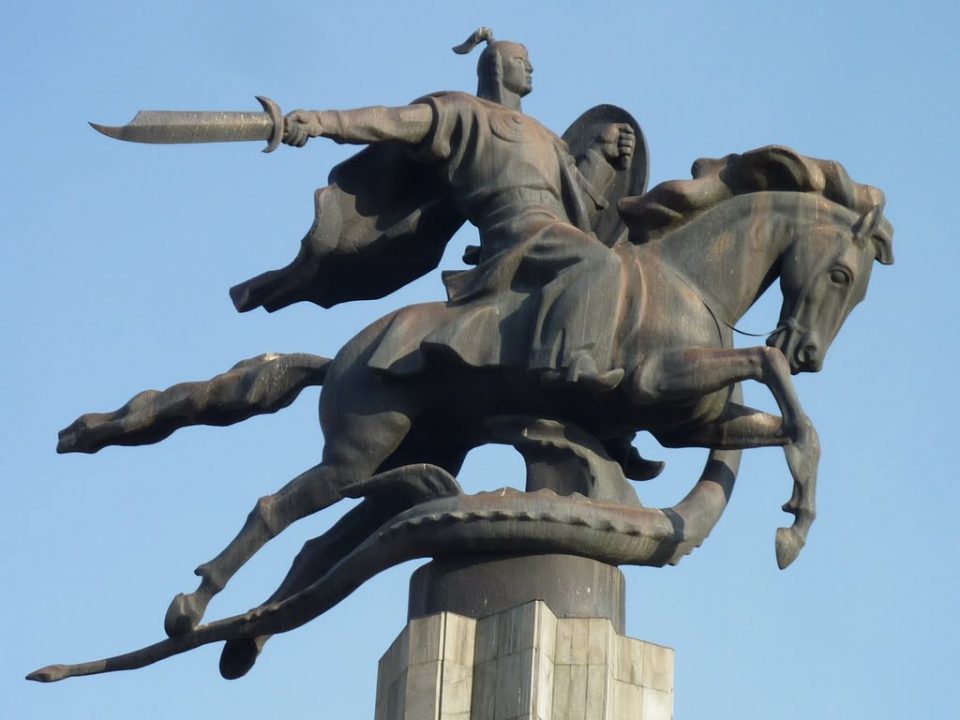키르기스 대서사시 ‘마나스’와 동명의 주인공 ‘마나스’를 만나다
[아시아엔=아크마랄 사바타르 키르기스스탄 NTS Channel 기자] 키르기스 문학의 최고봉은 역시 대서사시 ‘마나스’와 키르기스인을 통일한 같은 이름의 주인공 ‘마나스’다. 마나스는 유네스코 문화유산으로 지정돼 있다. 50만행이 넘는 길이로 세계에서 가장 긴 서사시로 꼽힌다. 이는 산스크리트어로 쓰인 대서사시 ‘마하바라타’의 2배가 넘으며 티벳 서사시 ‘게세르’보다도 길다. ‘마나스’는 ‘마나스’, ‘세메테이’, ‘세이텍’ 3부작으로 이루어져 있다.
키르기스를 통일한 마나스
마나스는 키르기스스탄의 고대 역사 연구의 중요한 사료가 된다. 마나스를 통해 시비족, 솔론족, 카라키타이족, 만주족, 나이만족 등 소수민족을 알 수 있을 뿐 아니라 당시 실크로드의 사회경제와 키르기스 상인들의 삶을 엿볼 수 있다.
이야기는 마나스가 태어난 순간부터 시작하여 마나스가 아버지와 함께 중국인과 칼미크인과의 투쟁에서 승리해 키르기스인들의 존경과 사랑을 받는 모습을 그린다. 하지만 마나스는 예상과 달리 구도자의 삶을 택하고 가족과 함께 중앙아시아 초원으로 떠난다.
2부 ‘세메테이’는 마나스가 떠나있는 동안 그의 삶과 키르기스인의 삶을 묘사한다. 중국의 침략으로 키르기스인의 땅은 피폐해졌고 마나스의 어린 시절 친구들, 많은 영웅들과 전사들은 투옥되었다. 이같은 소식을 들은 마나스는 구도의 길을 접고 돌아와서 중국의 왕과 아프간의 칸과 싸워서 이긴다. 그는 이번에도 삶의 지혜를 찾아 초원으로 떠난다.
3부 ‘세이텍’은 구도의 길에서 돌아온 마나스의 결혼생활과 자녀들에 대한 이야기다. 마나스의 죽음과 장례식까지 서사시는 계속 이어진다. 시에 따르면 키르기스인은 마나스에 대한 고마움으로 그의 무덤을 귀금속으로 장식했다고 한다. 서사시 ‘마나스’는 인간 마나스의 영혼과 유산을 물려받을 후손들에게 인간 마나스의 숭고한 인사를 남기고 끝난다.
이 대서사시는 군대 간 전투, 키르기스 결혼 풍습뿐 아니라 키르기스 여성들이 국가의 위기에 가정을 뒤로 하고 전선에서 함께 싸운 사실을 자세히 보여준다.
이렇게 길고 오래된 서사시의 구전에 필요한 시적·음악적 소양을 숙달한 이야기꾼들은 ‘마나시’라고 불리고 ‘민중예술가’로 존중받는다.
현대 역사가들은 <마나스>의 이야기 뼈대는 9세기경 키르기스 역사를 바탕으로 세워지고 15~18세기의 역사적 경험이 살로 붙어서 이루어 졌다고 추정한다. 또한 다른 시베리아 유목민들의 구전역사와 달리 ‘신화’라기보다는 ‘역사’에 가깝다고 평가받고 있다.
‘마나스’는 여전히 살아있다. 키르기스탄의 수도 비쉬케크의 국제공항은 마나스국제공항이며, 도시 속 대학에서, 영화관에서 마나스의 이름을 발견할 수 있다. 그러나 역시 가장 높이 빛나는 마나스의 이름은 소련천문학자 니콜라이 스테파노비치가 1979년 발견한 ‘마나스 운석’(No. 3349)일 것이다. <요약·번역 윤석희 기자>
다음은 영문으로 된 기사 원문.
The National Heritage of Kyrgyzstan: Manas
Akmaral SABATAR, NTS Channel Kyrgyzstan
The brightest pearl in Kyrgyz literature is the national epic “Manas,” and its eponymous main character-the hero who united the Kyrgyz. “Manas” is listed as the intangible cultural heritage of humanity by UNESCO. This epic consists of over half a million lines of poetry and is the longest epic in the world. “Manas” is twice as long as the Sanskrit epic “Mahabharata,” and even longer than the Tibetan “Epic of King Geser.” “Manas,” asrecorded by storyteller Sayakbai Karalaev, has 500,553 lines of verse. The epic consists of 3 parts: “Manas,” “Semetei,” and “Seytek.”
Manas-He Who United The Kyrgyz.
The epic traces the beginning of the state’s history. “Manas” is an important source for the study of ethnic history and ethnocultural relations in Kyrgyz, and is a source of more than one hundred ethnonyms of such people as Shibee(Shiwei), Solon, Kara-Kytai, Manju, and Naiman. “Manas” imprinted in their lines, information about the economy and merchants of the Kyrgyz. It refers to almost all the routes of the Silk Road.
The epic begins with the birth of the hero Manas. Even in youth, Manas(with his father) participated in confrontations with the Chinese and the Kalmyks, for which he received the respect and love of his people.
Afterwards, the hero becomes a holy Hyzr, and moves away to live with his family in the Central Asian expanse. “Semetei,” the second part of the epic, describes what happened to the Kyrgyz people, while Manas lived in other lands.
The Chinese invaded their land and imprisoned Manas’s best friend, other heroes, and the warriors. Manas learns about these events, and returns to defend his people. After his victories against the Chinese, and then with the Afghan Khan, Manas leaves again with the hermit, to discover the highest wisdom in life.
The last part, “Seytek,” describes the marriage of Manas and the birth of his children. Manas dies, and the reader learns the details of his funeral: The Kyrgyz people built a tomb for Manas, decorated with precious stones and metals, out of gratitude. Along with the hero’s death, his heroic legacy is passed on to those worthy receivers of “Manas.”
The epic holds everything, from a description of the military confrontation, to Kyrgyz religious beliefs, in an episode of Manas’s marriage to the daughter of a Turkish Khan. “Manas” describes how, in moments of acute danger from invaders, women abandoned their household affairs to heroically defend their homeland.
The transmission of such a voluminous and old epic requiredepic storytellers called the Manaschi. They are professional “People’s Artists” who have mastered thepoetic-musical telling of Manas.
Modern scientists have not reached a consensus about the origin of the story. They hypothesize that itcomes from the history of the Kirgiz in the IX century. Soviet linguist and literary critic Viktor Zhirmunsky-believed that the historical background matches the conditions XV-XVIII century, even though it has more ancient ideas.
Soviet cultural historian, Doctor of Philology, Professor Eleazar Meletinsky indicates that “Manas” is not mythical (as are many epic tales of the Turkic peoples of Siberia), but historical.
In Kyrgyzstan, there are many places named in honor of the epic. The Manas International Airport outside Bishkek, a university, and even a cinema. The brightest pearl to bear its name must be Asteroid(3349) “Manas” discovered by Soviet astronomer Nikolai Stepanovich Chernykh in 1979.






